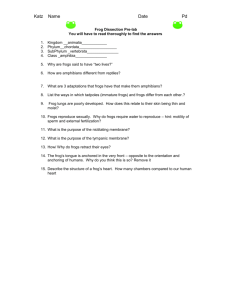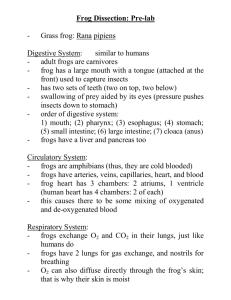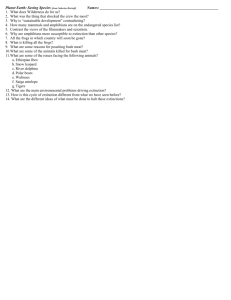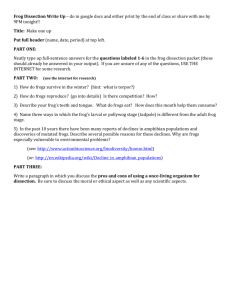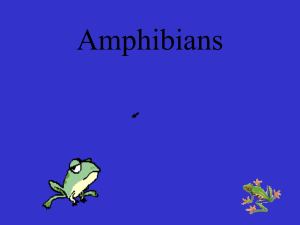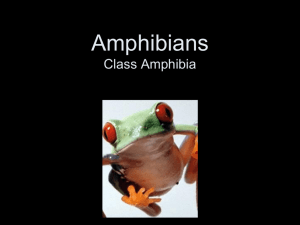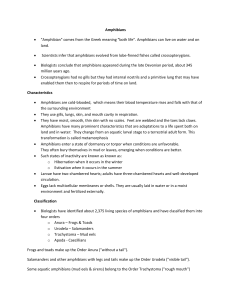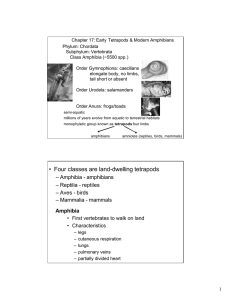Amphibians - Haughton Science
advertisement
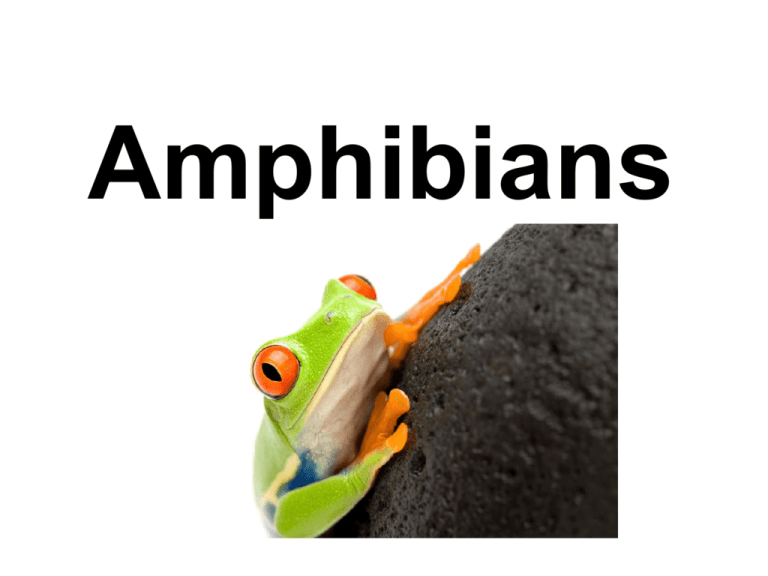
Amphibians What are some characteristics? Characteristics • Thin skin • Must go to the water to reproduce • Egg layers • Life cycle – eggs - tadpole to adult • Large eyes • 3 chambered heart • Front /fore and hind legs • Diverse colors and sizes • Amphibians have survived for hundreds of millions of years living in places where there is fresh water. • They are the only modern descendants of an ancient group that gave rise to all other land vertebrates. There are over 4,000 species of frogs! What are amphibians? • Means “double life” • The larvae have gills and the adults have lungs. • Adults live in the water and land. They breathe using both their lungs and skin. What are Amphibians? • They are vertebrates • Skin is thin and moist, have mucus glands • They lack scales and claws Evolution of Amphibians • The first amphibians were probably lobed finned fishes similar to the modern coelacanth. • Appeared in the Devonian period • They had the same challenges are the invertebrates did Form and Function in Amphibians Feeding: TADPOLES 1. Tadpoles filter feed or are herbivores 2. They eat constantly 3. Their intestines break down the cellulose from the plants and algae they eat Form and Function in Amphibians Feeding: ADULT FROGS 1. Adults are entirely carnivores 2. They eat anything they can catch and swallow Digestion Path of Food Tongue Mouth Glottis Esophagus Stomach Small Intestine (liver, gall bladder, pancreas) Large Intestine Cloaca – a large muscular cavity where the wastes, urine and eggs or sperms leave the frog’s body Frog Teeth Maxillary teeth – many small sharp teeth on the upper jaw only used for holding. Vomerine teeth – 2 of them on the upper roof of mouth, used for holding only Frog’s Tongue • Very sticky! • Long and can stretch • Attached at the front of the mouth Respiration Adult frogs – respiration is with the lungs and skin The lungs are well developed Larvae – respiration is with the gills and skin Circulation The frog heart has 3 chambers Left Atrium Right Atrium One Ventricle Excretion Frogs have kidneys that filter wastes from the blood. The excretory product of the kidneys is urine. It then travels through tubes called ureters into the cloaca. Reproduction Frog eggs don’t have shells and they tend to dry out if they are not kept moist. The females lay eggs (about 200) mostly in water. The male frog fertilizes them externally. Most frogs abandon these eggs to develop. Guess the different stages… Movement of Frogs Larvae Most amphibian larvae move very much like fish by wiggling their bodies and using a flattened tail for propulsion. Adult Frogs Use their front and back legs to move in a variety of ways Response Frogs have well developed nervous and sensory systems. Frog eyes are large and can move around in their sockets Nictitating membrane – a movable membrane is located inside the regular eyelid which can also be closed over the eye. This enables them to respond to moving objects. They don’t see color. Ecology of Frogs Scientists are concerned about the declining number of amphibians especially frogs. Why is this happening? What environmental threats? global warming decreasing habitat depletion of the ozone layer acid rain water pollution fungal infection aquatic predators increasing human population


